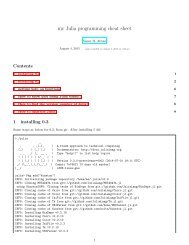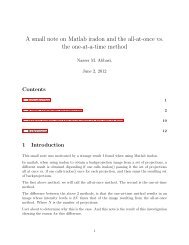You also want an ePaper? Increase the reach of your titles
YUMPU automatically turns print PDFs into web optimized ePapers that Google loves.
13 Velocity and acceleration of rigid body 2D<br />
<br />
V<br />
y<br />
x<br />
U<br />
V U<br />
y<br />
x<br />
U V<br />
Y<br />
X<br />
Linear<br />
Velocity<br />
diagram<br />
Rigid body,<br />
rotating at<br />
angular <br />
speed<br />
Linear<br />
acceleration<br />
diagram<br />
Notice the<br />
sign<br />
difference<br />
Nasser M. Abbasi<br />
Drawing_rigid_body_rotati<br />
on_1.vsd<br />
May 23, 2011<br />
a <br />
a x<br />
a y<br />
<br />
U V<br />
V U<br />
Finding linear acceleration of center of mass of a rigid body under pure rotation using fixed body coordinates.<br />
In the above U is the speed of the center of mass in the direction of the x axis, where this axis is fixed on<br />
the body itself. Similarly, V is the speed of the center of mass in the direction of the y axis, where the y axis is<br />
attached to the body itself.<br />
Just remember that all these speeds (i.e. U,V ) and accelerations (a x , a y ) are still being measured by an<br />
observer in the inertial frame. It is only that the directions of the velocity components of the center of mass<br />
is along an axis fixed on the body. Only the direction. But actual speed measurements are still done by a<br />
stationary observer. Since clearly if the observer was sitting on the body itself, then they will measure the speeds<br />
to be zero in that case.<br />
57





